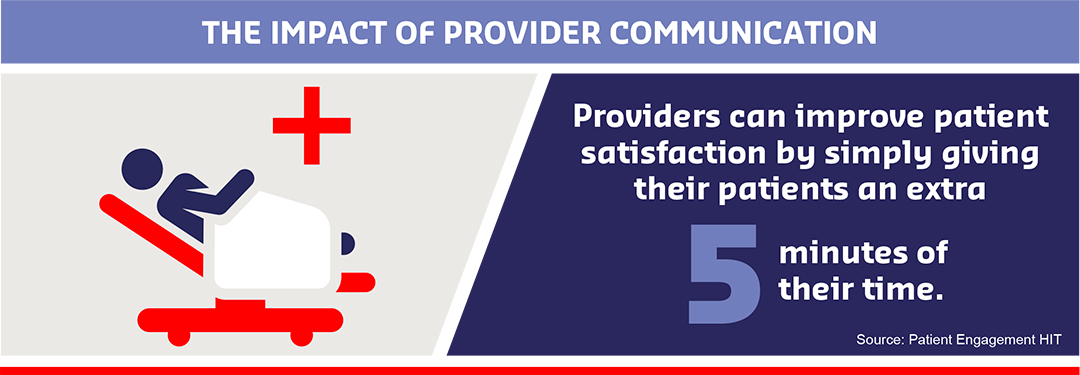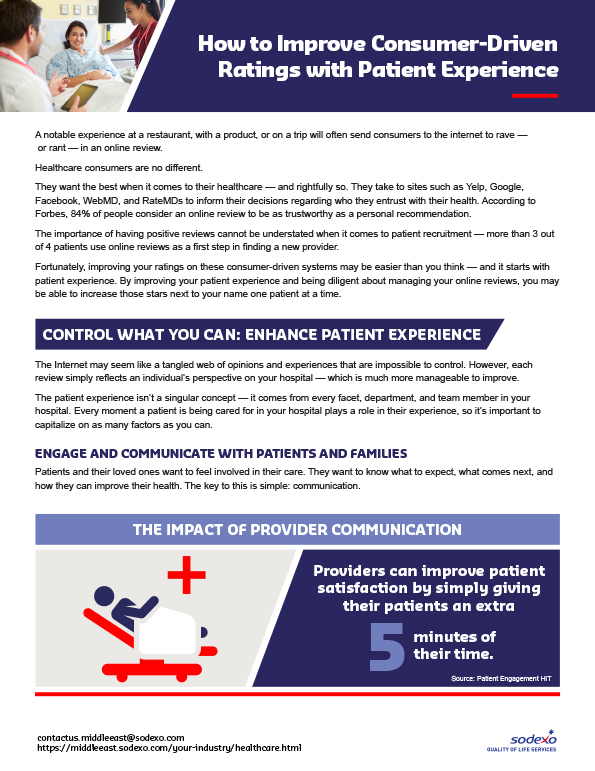A notable experience at a restaurant, with a product, or on a trip will often send consumers to the internet to rave — or rant — in an online review.
Healthcare consumers are no different.
They want the best when it comes to their healthcare — and rightfully so. They take to sites such as Google, Facebook, and WebMD to inform their decisions regarding who they entrust with their health. According to Forbes, 84% of people consider an online review to be as trustworthy as a personal recommendation.
The importance of having positive reviews cannot be understated when it comes to patient recruitment — more than 3 out of 4 patients use online reviews as a first step in finding a new provider.
Fortunately, improving your ratings on these consumer-driven systems may be easier than you think — and it starts with patient experience. By improving your patient experience and being diligent about managing your online reviews, you may be able to increase those stars next to your name one patient at a time.
CONTROL WHAT YOU CAN: ENHANCE PATIENT EXPERIENCE
The Internet may seem like a tangled web of opinions and experiences that are impossible to control. However, each review simply reflects an individual’s perspective on your hospital — which is much more manageable to improve.
The patient experience isn’t a singular concept — it comes from every facet, department, and team member in your hospital. Every moment a patient is being cared for in your hospital plays a role in their experience, so it’s important to capitalize on as many factors as you can.
ENGAGE AND COMMUNICATE WITH PATIENTS AND FAMILIES
Patients and their loved ones want to feel involved in their care. They want to know what to expect, what comes next, and how they can improve their health. The key to this is simple: communication.

CONTROL WHAT YOU CAN: ENHANCE PATIENT EXPERIENCE
To allow your providers to spend more time with their patients, you may need to take some administrative responsibilities off their hands. Third-party vendors can manage tasks such as responding to phone calls and transporting patients and equipment — and your providers can spend their time where they’re needed most.
CREATE AN ENVIRONMENT THAT PREVENTS COMPLICATIONS
Patients come to your hospital for one reason — to be healthy. While your providers are well-trained in providing the necessary treatment, it’s important to ensure your patients don’t experience any unplanned complications while they’re in your care.
Common complications that can negatively impact patient experience include:
- Healthcare-associated infections, which can be caused by an unclean hospital environment.
- Misdiagnosis, which can be caused by medical equipment that’s not working properly, and may affect 20%of patients with serious medical conditions
These complications are avoidable if you have teams that are specifically trained in areas such as keeping your hospital clean and disinfected, managing your medical equipment, providing clinical nutrition services, and protecting your patients’ information.
Having the right teams to handle factors of patient care that go beyond medical treatment can make a patient’s overall experience go much more smoothly. It can help them feel safe and supported as they recover.
OPTIMIZE THE PATIENT EXPERIENCE WHENEVER POSSIBLE
Caring for a patient’s health is a given in a hospital setting. But when your hospital takes the time to go above and beyond during their stay, that’s what your patients will remember.
One significant factor in a patient’s experience is the food they eat. Some hospitals are shifting to room-service style for patients, more nutritious options, local food sourcing, and even gourmet meals — and these changes are paying off. For example, one study found that patient satisfaction ratings increased from the 68th to the 86th percentile overall after implementing room-service style dining.
PUT SOME PURPOSE INTO GETTING REVIEWS
So, you’re confident your patients’ experiences reflect the quality of your hospital — now what?
Getting patients to post about their experience may seem daunting, but with a purposeful strategy, it can be manageable and effective.
Be deliberate when it comes to getting positive online reviews. Patients may use reviews as a trusted resource, but they may not actively write reviews. Don’t assume that patients who have had a positive experience in your hospital will post anything — if you want an online review, ask for it.
There are several strategies for encouraging online reviews, but be careful about exactly how you ask.
Some strategies to encourage online reviews include:
- Asking patients, either directly, by hanging a sign in the waiting room, or by posting a note on your website
- Sending an email to patients after their visit asking them to review your hospital, and include a direct link
- Offering an incentive for writing a review, such as a small gift card to your gift shop or a free coffee in your cafeteria
It’s also important to make sure that your hospital exists on major platforms, such as Google, Facebook. Be sure to check that the recommendation option is on so that when patients decide to review your hospital, they’re able to do so.
STAY ON TOP OF YOUR REVIEWS
Reviews provide real data that show how your patients view your hospital. You — or a delegated person on your team — should actively look at your hospital’s reviews. More than half of all providers look at their own reviews to understand how their patients view them and make improvements, as necessary.
Remember that despite your best efforts, some negative reviews are inevitable. Mistakes happen, and there will always be that one person who had a bad day and decided to let their anger out in a review.
A couple of bad reviews here or there aren’t going to cause too much damage. In fact, one study found that moderately positive reviews — as opposed to reviews that sing your hospital’s praises — are more believable. Consumers tend to think they are more thoughtful and realistic. For consumers, a balance of reviews can often be a good thing.
Remember — negative reviews are an opportunity for growth. Almost half of consumers are only concerned with reviews from the past 2 weeks. It’s important to keep a consistent eye on your reviews — and continue to prioritize the experience of the patients in your hospital to improve them.

